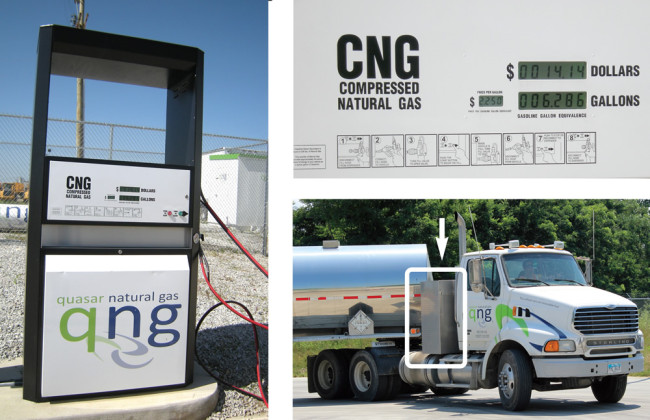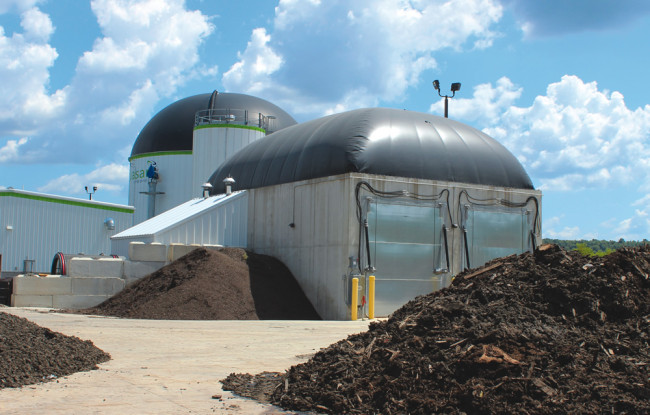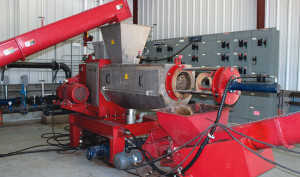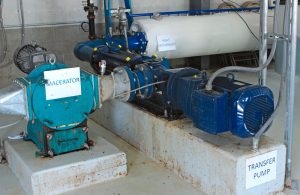What seemed like a “slam dunk” in 2006 — bringing the European model of digester success to the U.S. and rapidly building a company — turned out to be a longer haul, but one that has been rewarding for quasar energy group.
Nora Goldstein
BioCycle September 2013, Vol. 54, No. 9, p. 44
 IN 2006, the four employees who made up quasar energy group were optimistic that selling America on anaerobic digestion (AD) would be easy. There were 4,000 digesters operating successfully in Europe, the industry was booming, and technology providers couldn’t build the systems fast enough to meet the demand, recall the company’s founders, Mel Kurtz and Steve Smith. “There didn’t seem to be a logical reason that the same popularity couldn’t be achieved in the U.S,” says Kurtz, quasar’s president. “As it turned out, there were many.”
IN 2006, the four employees who made up quasar energy group were optimistic that selling America on anaerobic digestion (AD) would be easy. There were 4,000 digesters operating successfully in Europe, the industry was booming, and technology providers couldn’t build the systems fast enough to meet the demand, recall the company’s founders, Mel Kurtz and Steve Smith. “There didn’t seem to be a logical reason that the same popularity couldn’t be achieved in the U.S,” says Kurtz, quasar’s president. “As it turned out, there were many.”

Four quasar digesters upgrade biogas to “qng” compressed natural gas, which retails for an average of $2.25/gasoline gallon equivalent (fueling station at left). About 30 quasar vehicles, including some tanker trucks, are equipped with CNG engines (see arrow above).
A primary reason why the European experience couldn’t be replicated easily in the U.S. was the business model. “The popularity of European digesters was due to the availability of government incentives for generating renewable electricity,” says Kurtz. “And many systems operated on expensive corn as their primary feedstock. We recognized that the European model would not work in Ohio, where corn was a commodity and the average selling price of electricity was $.05 per kW. The German technology would have to be redesigned to manage a wide variety of feedstocks that our plants would be paid to receive — waste streams from generators that were already paying to have their material sent to a landfill, incinerator or treatment facility.”
Starting From (Almost) Scratch
In 2007, Kurtz recruited Clemens Halene, whose experience was in the automotive industry in Ohio, to lead quasar’s engineering initiatives. Halene, a German native, recognized the need to develop a specialized staff of in-house digester engineers to tackle the design modifications. “You can’t just hire digester engineers in a country where there isn’t an anaerobic digestion industry — you have to recruit talented engineers and invest time into making them digester specialists,” says Halene. His experience with suppliers and lead times in the automotive industry quickly led to the conclusion that quasar’s original plan — to bring components in from Europe — was not feasible. “That meant longer lead times or maintaining a larger inventory — two options that didn’t work for our small company,” explains Kurtz. “Clemens was able to tap into his existing relationships, and he and our engineering team redesigned the systems so we could use locally sourced components and, in many cases, custom designed components.”
The company also recognized the need for a laboratory dedicated to testing incoming waste streams and monitoring the biology. It started with a small lab in Aurora, Ohio, then in 2008 quasar initiated talks with The Ohio State University’s Ohio Agricultural Research and Development Center (OARDC) in Wooster to collaborate on a state-of-the-art laboratory. By October 2008, the company moved its small engineering team and new laboratory staff onto the OARDC campus to collaborate with one of the largest agricultural bioscience research centers in the country.
In the same year, the financial markets fell into turmoil and traditional lending sources dried up. As quasar was getting ready to construct its first full-scale facility in 2008, the lender providing financing for the project pulled its commitment letter due to the turmoil in the banking industry. Quasar’s plans to sell systems evaporated. Without a customer willing to partner on a facility, quasar had to invest more of its own capital, putting a strain on operations. “We ended up being able to partner with OSU-OARDC to secure property for the project, and completed our first facility in the BioHio Research Park on the OARDC campus in early 2010,” says Smith. “The relationship was fortuitous — OARDC gave quasar something we didn’t have on our own — credibility. While no one knew quasar, everyone knew OSU and the OARDC campus.”
However, for customers interested in buying a digester, one operating system was not a track record. “We were forced to follow the financial path used for the Wooster project and built the Columbus and Zanesville (Ohio) facilities as the majority owner and operator,” he adds. When federal monies became available via the U.S. Treasury’s Sec. 1603 grants in 2009 — as a result of the American Reinvestment and Recovery Act stimulus — quasar utilized those funds, as well as USDA’s REAP grants. “The stimulus funds and federal grants plugged a hole in the capital markets because of the banks’ poor balance sheets,” notes Smith. “We replaced the senior debt no longer available in the market with public funds.”
Penciling Out
Over the course of quasar’s start-up years, Smith, Kurtz and Halene invested a significant amount of time figuring out a long-term financial model that would grow the company, and in turn the industry. Smith explains that for every dollar quasar invests in its facilities, it expects a one-fifth return each year. “That is reoccurring income, and we are surpassing that in most cases with our digesters,” he says. “As long as we can accept and process material for less than the market rates for traditional disposal, we are good. In Ohio, that means managing materials at tipping fees ranging from $30 to $50/ton, depending on the feedstock. And anything that comes out the back end is a product with significant value. For example, the digester effluent is a nutrient-rich alternative fertilizer with a market value of $200 to $300/acre.”
Financing is secured in a variety of ways, including forming partnerships with entities such as Forest City Enterprises, a national real estate developer headquartered in Cleveland (see “Why Is A Real Estate Giant Bullish On AD?” in this REFOR13 Conference Preview). “Forest City wants to make investments in underutilized assets in order to generate electricity and fuels to offset energy use in its properties,” explains Kurtz. “I view our partnership with Forest City as the definition of synergy.”
One target market for quasar energy group is wastewater treatment plants. For example, it partnered with the French Creek Wastewater Treatment Plant and the city of North Ridgeville, Ohio to construct a 1MW anaerobic digester that manages all of the sludge currently produced at the treatment plant. The facility also processes organic waste streams from area generators, such as food waste and FOG. “The French Creek treatment plant had no capital outlay, and the digester reduces its operating costs as AD is a less expensive alternative than sludge disposal,” explains Kurtz. “And it gets a discount on electricity as well.” For quasar, wastewater treatment plants can be a less complicated path to siting facilities. The company is currently retrofitting idle digesters at the City of Wooster’s WWTP under a similar public-private partnership as French Creek.
Renewable Fuel
While Kurtz talks excitedly about all aspects of quasar, he is perhaps most enthusiastic when discussing “qng”, which is produced at four of its operating digesters, with more qng fueling stations coming on line. “The saying I use is ‘it is easier to sell $4/gallon fuel for $2/gallon than it is to sell $0.07 kWh electric for $0.09,’” he explains. “The most challenging time for installing and selling CNG will be the first day you enter the market. Unless you believe the cost of energy — especially motor vehicle fuel — will come down, the longer you are in the business, the more profitable you will be. From a purely economic standpoint, a company such as quasar with more than a dozen plants in Ohio can produce in excess of 30,000 gasoline gallon equivalents (gge)/day.”
The economic case becomes even more compelling because tipping fees offset “production” costs, and there aren’t any wheelage fees (i.e., via the natural gas pipeline) or transportation expense to deliver it, he adds. Quasar pays itself $0.75/gge (8 GGE/$6 mmbtu). The average retail price at its qng stations is $2.25/gge. The fueling stations are open to the public and can be accessed by creating an account.
Sourcing components for the qng stations was initially a challenge for quasar. “When we ordered our first dispenser, the supplier said it would take four to five months,” recalls Kurtz. “We can’t have that kind of delay on deliverables and build an industry, so we built our own supply chain and assembled what we needed for the dispensers at our Zanesville and Columbus digesters.”
Managing Effluent
Among the realities of operating so many digesters is the quantity of effluent generated. “We are managing upwards of 175 million gallons of effluent on an annual basis, which is a challenge,” says Smith, especially during months when access to agricultural fields is limited. In addition to its equate product (an NPK supplement designed for agricultural land application), quasar has started marketing qbio, an adsorption product that binds nutrient-rich anaerobic digester effluent with woody waste materials (such as yard trimmings) to accelerate composting.
The effluent also is used in the company’s Integrated AD System (iADs), which was developed in collaboration with The Ohio State University. The iADs can treat and recover energy from feedstocks ranging from 0.5 to 85 percent total solids content. For example, the Zanesville facility has a 2-bay iADs; each bay has 200 cubic yards of capacity. Ground wood waste (about 3-inch minus) is loaded into the bays. Four nozzles inside each bay spray about 1,000 to 2,000 gallons/day of effluent, providing continuous moisture. Material stays under anaerobic conditions for four to five weeks, utilizing the methane potential still left in the effluent. The wood waste contained in the bays can then be composted — utilizing qbio to accelerate the process. “The composting and dry digestion definitely helps with effluent management, especially in the summer months,” says Chase Smith, operator of the Zanesville plant.

In addition to the wet digesters, the Zanesville plant has a
2-bay integrated Anaerobic Digestion system that can treat and recover energy from feedstocks ranging from 0.5 to 85 percent solids. Ground wood waste is loaded into the bays,
[caption id="attachment_20162" align="alignleft" width="300"] The Dupps Company depackaging system significantly expands the types of food waste that the Zanesville facility can receive.
The Dupps Company depackaging system significantly expands the types of food waste that the Zanesville facility can receive.
4 to 5 weeks.[/caption]The Zanesville digester also has a depackaging system supplied by The Dupps Company, which significantly expands the types of food waste the facility can receive. “We’ve been getting a lot of dairy products and canned goods, and this summer, we were getting truckloads of drums filled with juice,” says Kurtz. “We are actually now looking at another sideline business of drum reconditioning! Our next step will likely involve putting in some cold storage and perhaps a second depackaging line.”
Reflecting on quasar’s start-up years, Kurtz concludes: “Our plans were small and our expectations for how easy this would be were completely unrealistic. The road we have traveled to get to this point has been anything but easy. The industry we have helped to grow is our unexpected reward.”











